Serie A title contenders Napoli hosted Premier League strugglers Leicester City in the UEFA Europa League on Thursday in the final game of the group phase.
The stakes were high in this match and the players, coaching staff, and supporters from both sides were made well aware of what a poor result in this fixture could mean for either team.
The Foxes were top of the group heading into Thursday night’s battle at the Stadio Diego Armando Maradona with seven points while the Azzurri were also on seven but had a worse head-to-head record.
A loss for either team meant they would be heading out of the Europa League and down into the playoffs for the UEFA Europa Conference League
Unfortunately for Brendan Rodgers’ side, it was them who were put to the sword and the Northern Irishman’s tenure at the King Power Stadium is increasingly under the microscope given the team’s poor form this season.
The game was excellent from a tactical perspective which resulted in a wonderfully entertaining game of football in Naples with Luciano Spalletti’s side coming away with a 3-2 victory.
This article will be a tactical analysis of the European game. It will be an analysis of the tactics deployed by both sets of managers which resulted in Napoli taking all three points.
Lineups and formations
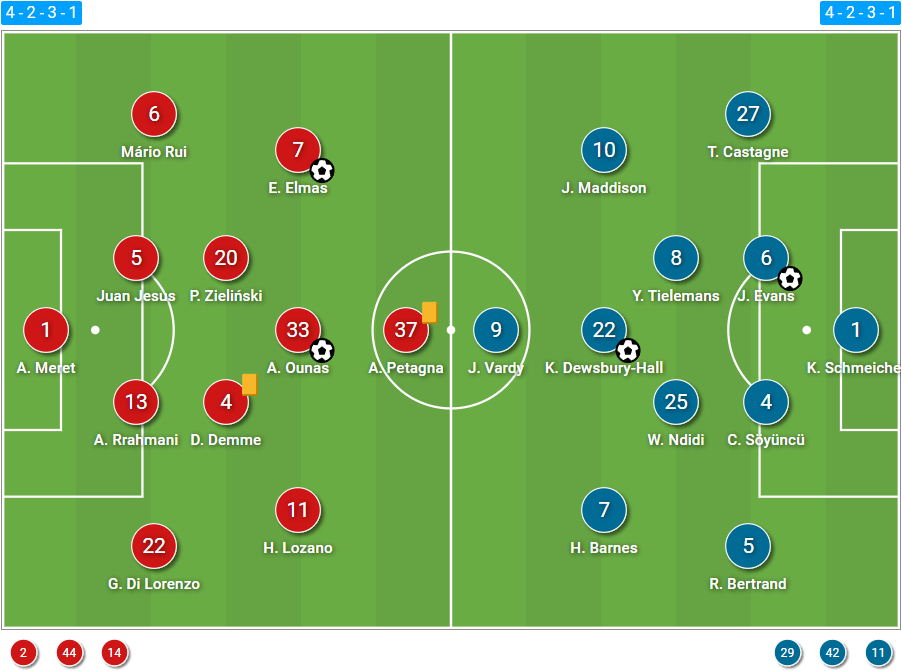
Napoli have been in some turbulent form recently which has put a massive dent in their hopes of winning Serie A this season. Spalletti rotated quite a lot of players as the home side have some tough fixtures coming up, beginning with Empoli at home before a visit to the San Siro to take on table-toppers Milan.
The Italian coach has switched between a 4-3-3 and a 4-2-3-1 recently but opted to go with the latter against the 2016 Premier League champions.
Alex Meret return to the lineup, sitting behind a back four comprised of Mario Rui, Juan Jesus, Amir Rrahmani, and Giovanni Di Lorenzo. Spalletti picked Diego Demme and Piotr Zielinski in the double-pivot in front of the backline with Adam Ounas deployed as the number ‘10’.
Hirving Lozano kept his place in the team as the right-winger with Elif Elmas on the opposite flank. Andrea Petagna replaced Dries Mertens in the team as the lone striker.
Meanwhile, Rodgers didn’t make too many changes from the starting lineup that lost to Steven Gerrard’s Aston Villa on Sunday, maintaining their 4-2-3-1 formation. Peter Schmeichel kept his place in goal, protecting a backline of Ryan Bertrand, Caglar Soyuncu, Jonny Evans, and Timothy Castagne.
Youri Tielemans was back in the side, playing alongside Wilfred Ndidi while Kiernan Dewsbury-Hall roamed in the ‘10’ position behind Jamie Vardy as the lone striker. Harvey Barnes remained on the left-wing while James Maddison was shoehorned out to the right, having been in the number ‘10’ positions against the Villains at the weekend.
Ndidi’s role and problems with Leicester’s press
Leicester set up in a 4-1-4-1 out of possession in the high pressing phase as opposed to a 4-2-3-1 in possession. Rodgers switched to the 4-1-4-1 to deal with Napoli’s 4-2-3-1 as the two systems match up perfectly in the midfield and on the flanks and so allowed the visitors to go man-to-man.
Leicester did just this against the Azzurri’s 4-2 build-up structure. Ndidi’s role was more of a mix of zonal and man-oriented, although his primary job to sit on Ounas.
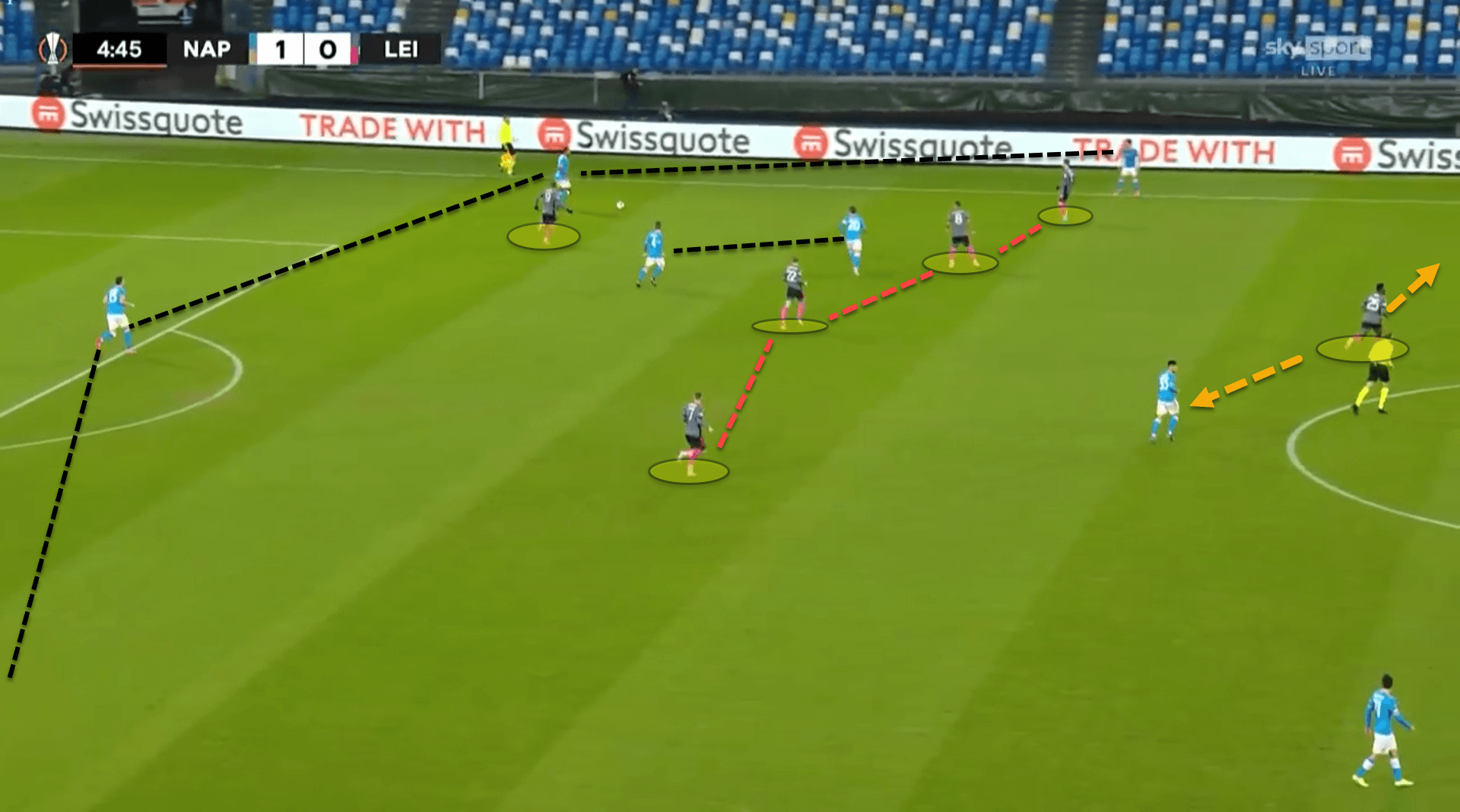
Ndidi would only leave his man if another Napoli forward dropped short to receive from the backline and a Leicester defender was unable to deal with it.
Essentially, Rodgers’ instructions to the Nigerian international when Leicester were out of possession were to man-mark Ounas but to also mark any other players that come short between the lines to receive a pass. The nearest passing option was always the priority.
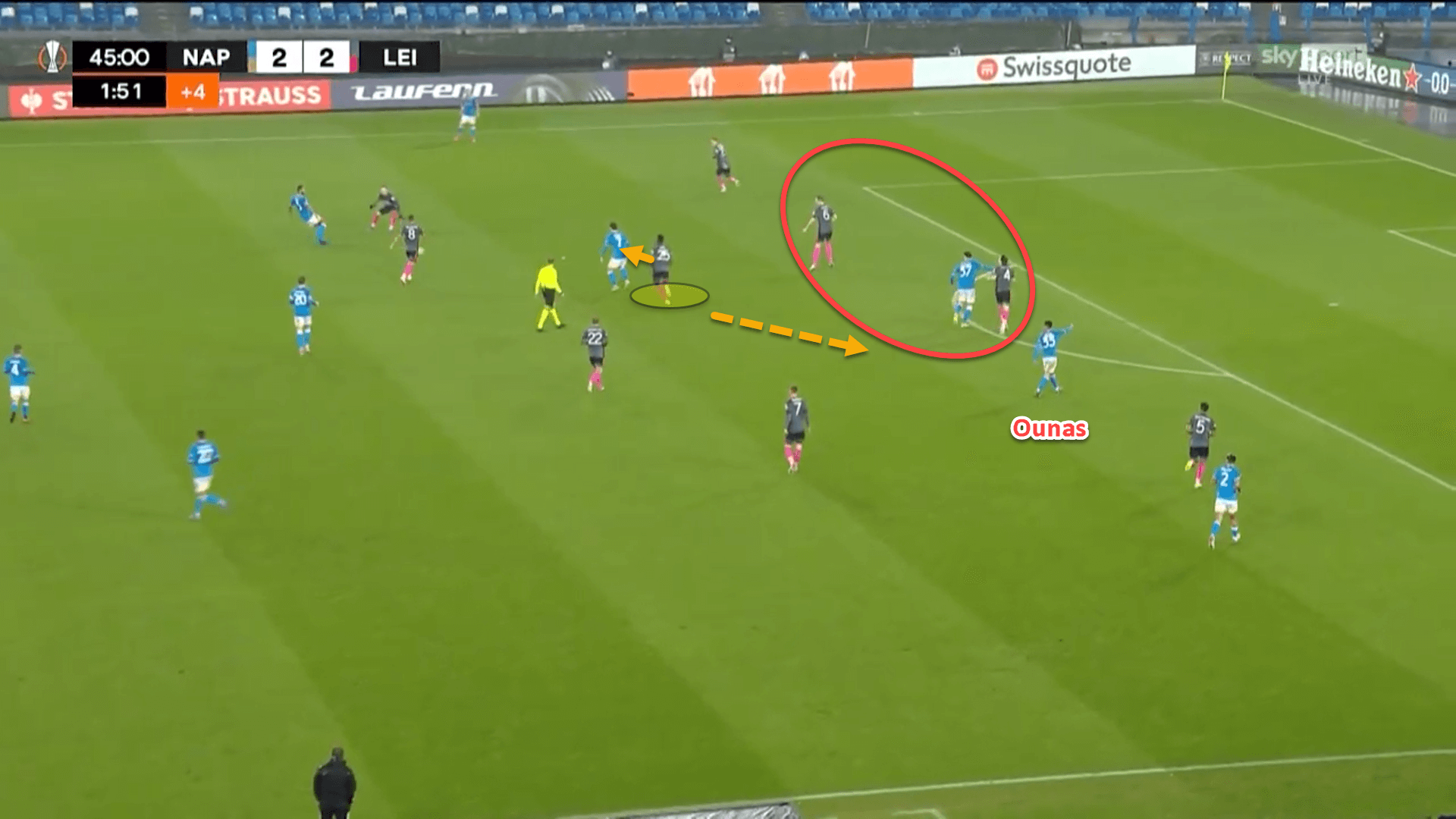
In this instance, Leicester were parked in their 4-1-4-1 low block at the edge of the box. Elmas is receiving the ball between the lines Petagna has pinned the two centre-backs, meaning the only other player capable of dealing with the situation is Ndidi.
The midfielder leaves Ounas to close Elmas down which allows the former to drift into a dangerous position on the last line, but the nearest passing option was his first course of action.
When the Foxes pressed high, Jamie Vardy was tasked with shaping his pressure to cut off the passing lane to one of the centre-backs which would force Napoli to play out wide. This would trigger wide pressing traps for Leicester who would aggressively try to regain possession.
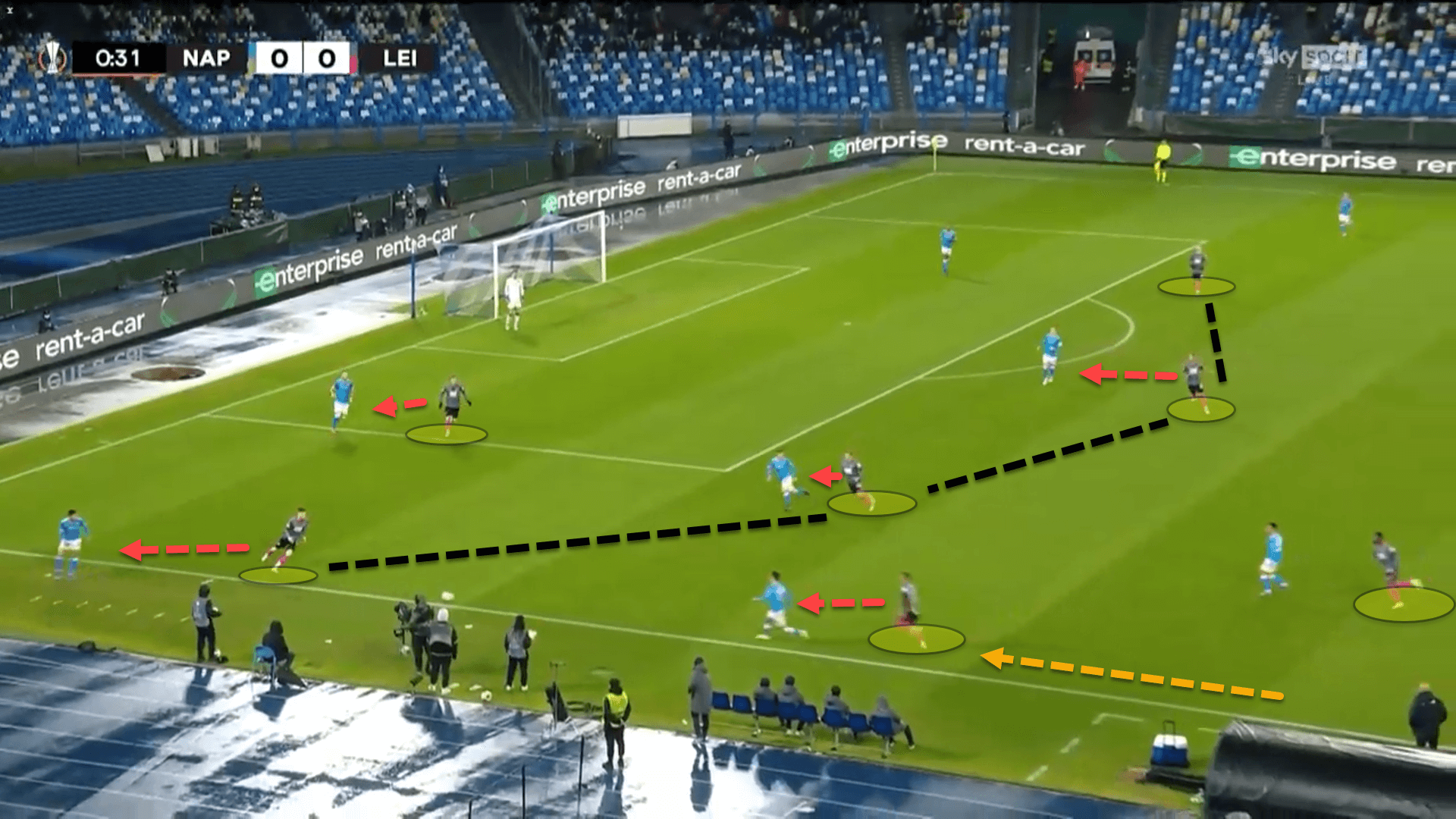
Again, Leicester would go man-for-man here and tightly marked the ball-near passing options to ensure that Napoli couldn’t progress forward.
The fullback was even instructed to push high if the winger dropped to receive – as can be seen with Bertrand in the image above. This would prevent any chance of clean progression for the home side.
Napoli actually struggled quite a bit with this Leicester high press particularly when the wide pressing traps were triggered. It forced them to go long quite a lot, particularly in the first half when Leicester’s press was at its most intense. The Foxes finished the match with a Passes allowed Per Defensive Action (PPDA) of 7.5.
Nonetheless, this actually caused issues for Leicester. Having Petagna as a target man up front caused a lot of issues for Soyuncu and Evans in the air and Napoli were winning quite a lot of the second balls from these direct passes up to the experienced striker.
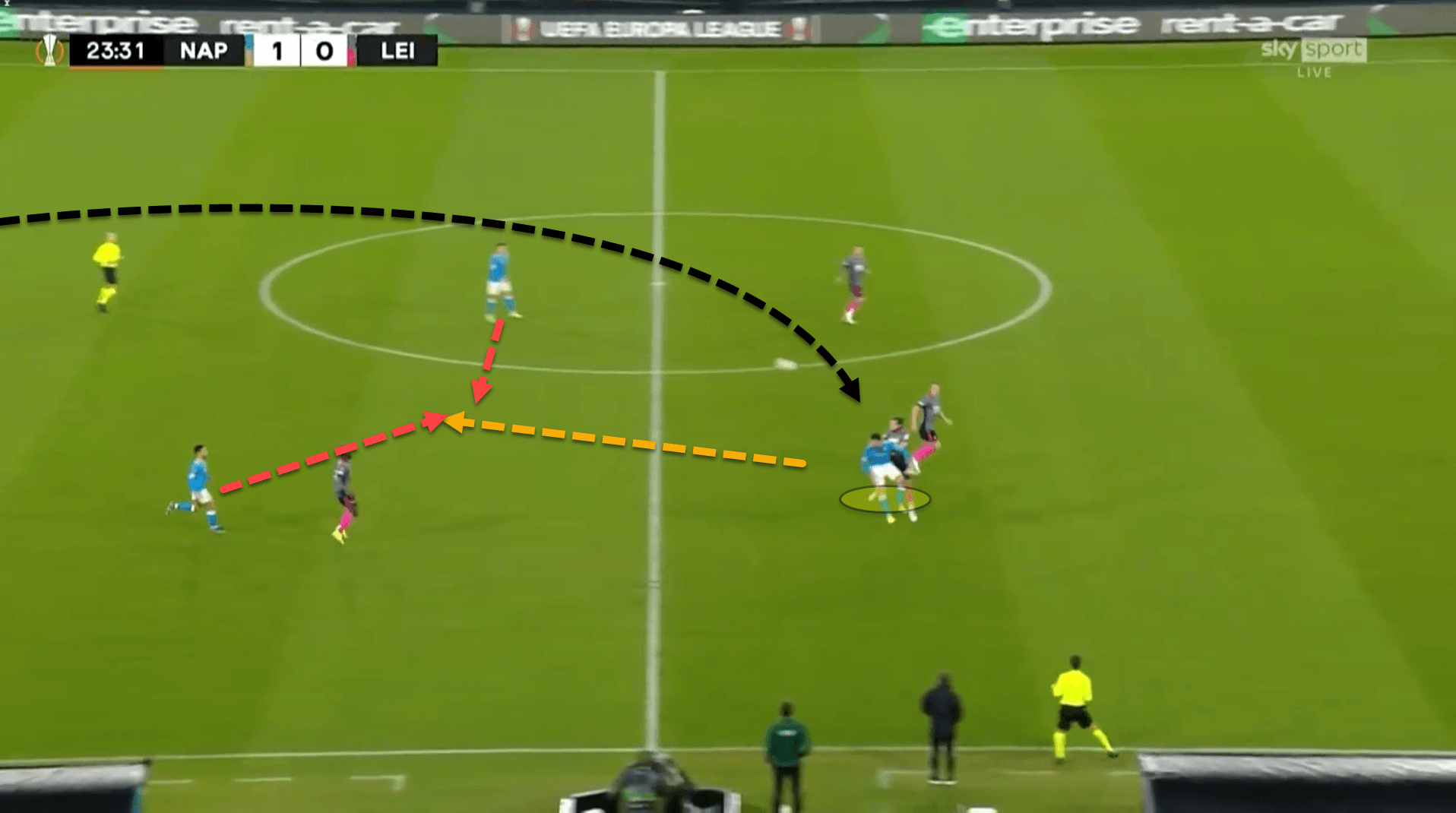
It was Ndidi’s job to sweep up the second balls from these long balls but often the number ‘6’ found himself outnumbered 2v1 or else he was too slow to get there.
Ndidi was not at his scintillating best unfortunately for Rodgers who relied quite heavily on the 24-year-old to perform a number of duties defensively.
This was the build-up that led to the second goal for Spalletti’s side. Leicester were high-pressing really well and so Rrahmani opted to go long to Petagna who contests well with Soyuncu for the aerial ball although the latter actually wins the duel.
Eventually, the play develops and within 16 seconds, the ball was in the back of the net. Napoli tried to pass out from the back as their first option but if this wasn’t working, they would go long to Petagna, an excellent way to be unpredictable in possession.
The Azzurri played long passes throughout the match with a 64.71 percent accuracy. The most used long pass link was from the centre-backs to Petagna.
Leicester’s possession failures
In possession, Leicester set up in a slightly unorthodox and lopsided 4-2-3-1 but with a box midfield which has been in the news recently since Ralf Rangnick’s shift to the 4-2-2-2 tactical system at Manchester United.
The base formation for the Foxes was a 4-2-3-1 but when Maddison inverted to create room for Castagne who pushed high and wide, it became a 4-2-2-2 with a box midfield.
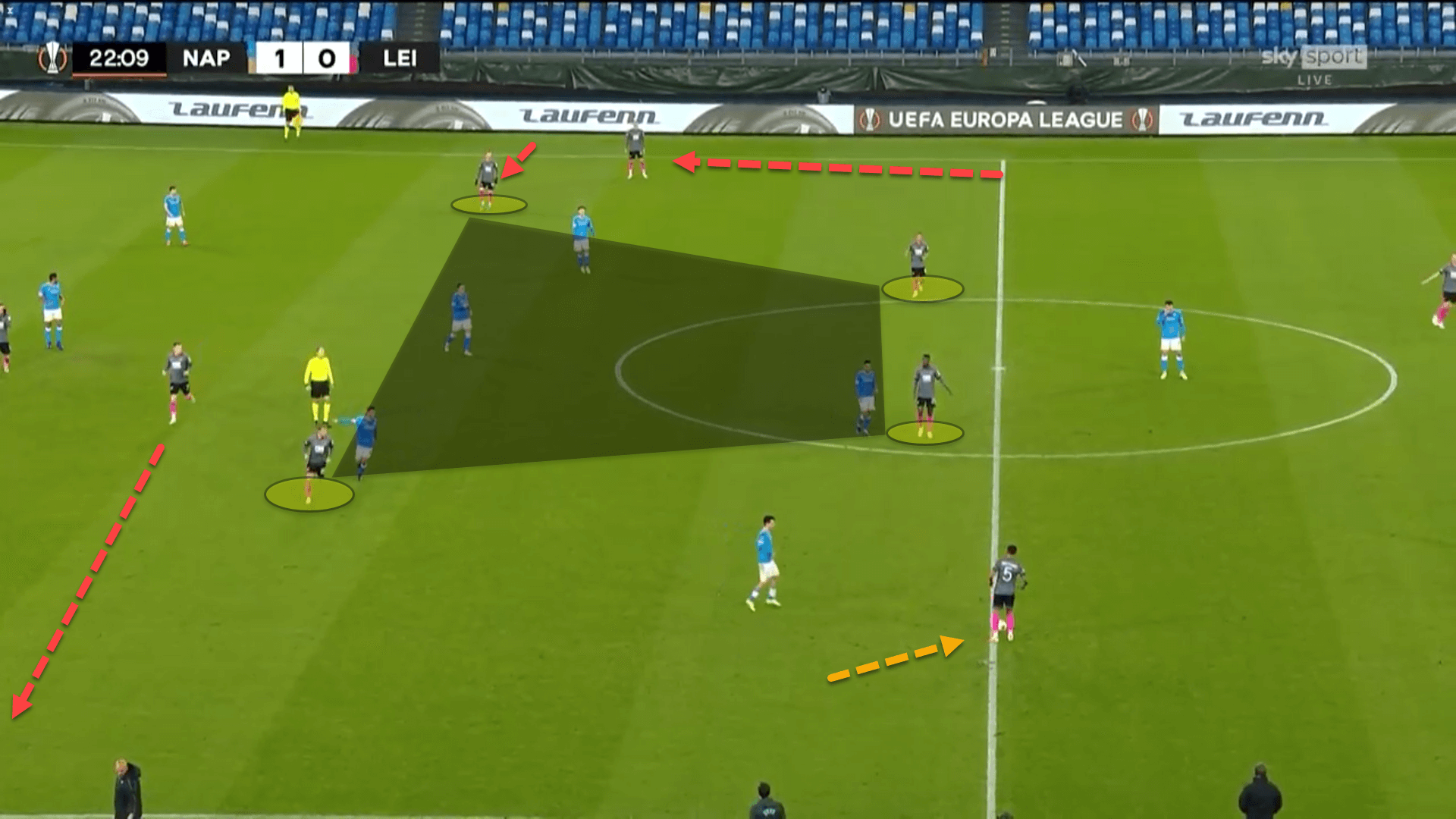
Barnes and Castagne held the width for the visitors on the flanks while Ryan Bertrand always stayed slightly deeper to create a three-man backline against Napoli’s first line of pressure ensuring that Leicester always had the ball in a 3v2 against the home team’s two centre-forwards.
This positional attacking shape can also be seen from Leicester’s average positions and pass map from the game. Pay particular attention to the box shape in midfield.
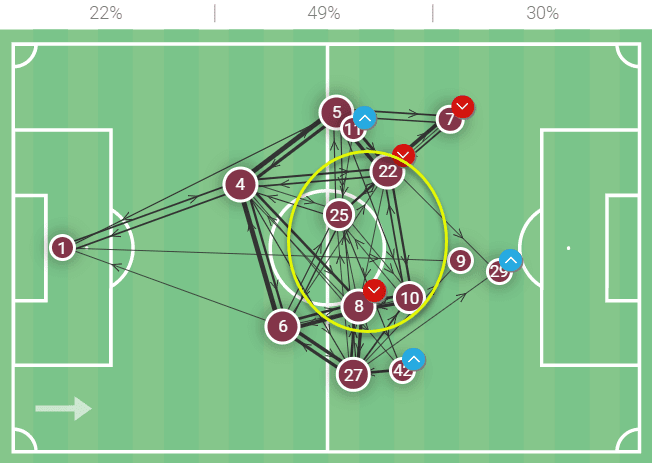
Napoli were defending in a 4-4-2 out of possession with Spalletti instructing his players to be aggressive against Leicester’s double-pivot, cutting off the passing lanes into them and jumping them when they received the ball with their back to goal.
The Italian giants executed this quite well and Leicester were struggling to play through the central areas, focusing their play down the flanks instead or through long balls into the channels.
Napoli’s first line of pressure, Ounas, and Petagna were tasked with pressing the centre-backs while applying cover shadows to the double-pivot. However, if the cover shadows failed and the ball made its way to either Tielemans or Ndidi, Napoli’s defensive midfielders were ordered to pressurise their opposite numbers.
In fact, Napoli’s first goal came from this very aggression of the double-pivot.
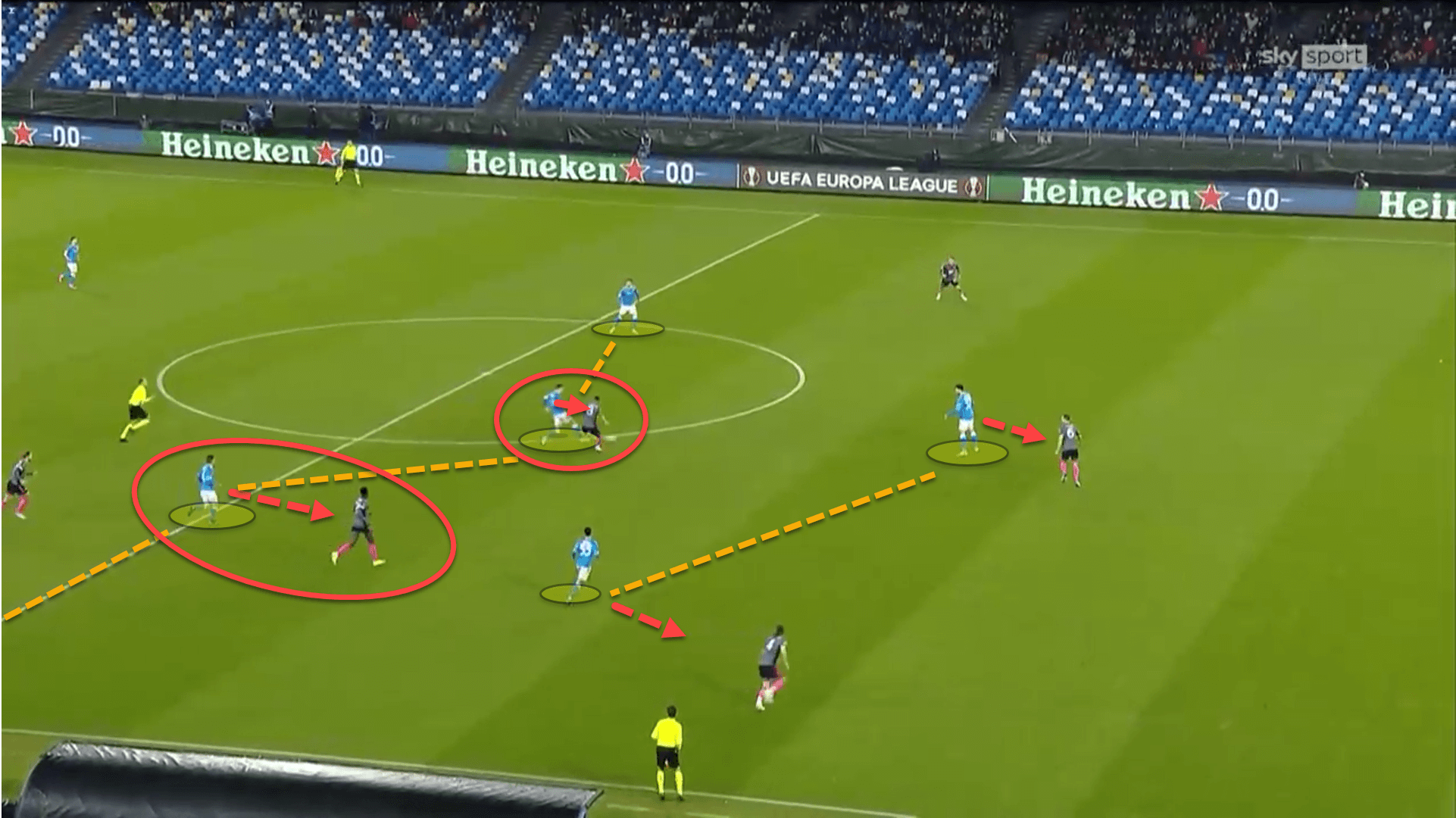
Zielinski has nipped the ball from Tielemans before he can turn in possession and play forward. Napoli regain possession and transition quickly against an exposed Leicester backline with the ball eventually reaching Ounas who swept it into the bottom corner past Schmeichel.
Rodgers tried to make Leicester’s build-up play from deeper areas much smoother once it was clear that the backline and double-pivot were struggling to play out of Napoli’s press. He instructed Dewsbury-Hall to start dropping deeper alongside Ndidi and Tielemans to help with ball progression up the pitch.
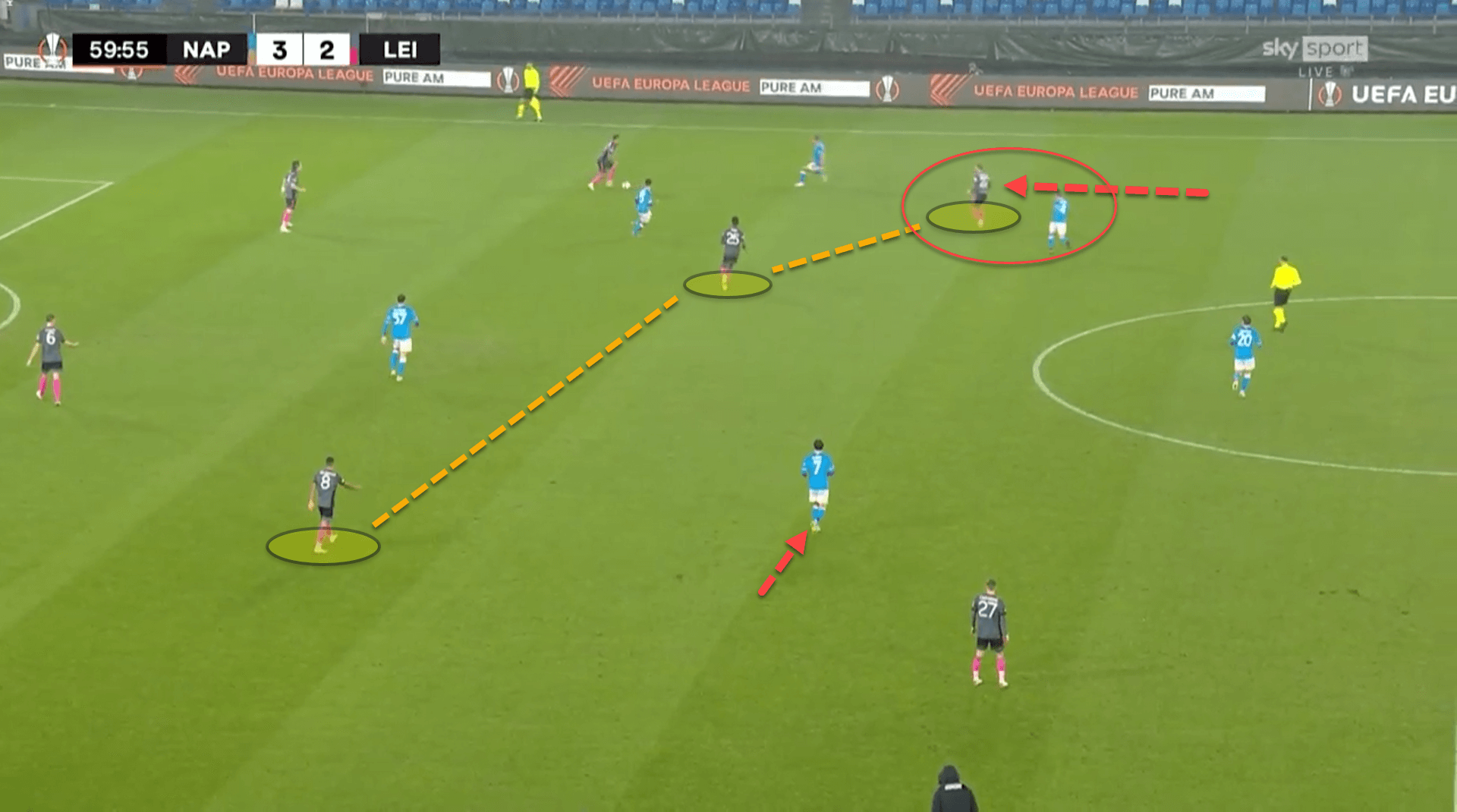
This still did not work for the Foxes. Napoli just compacted their 4-4-2 block, even more, to ensure that the players were closer together to deal with any Leicester players that were free.
Rodgers’ side were getting some joy by playing down the flanks instead. As Napoli were condensing the central space, there was room on the sides for the visitors to try and progress the ball down. Leicester especially used the left flank to do so.
In 34 positional attacks had by the English team, 27 were down the wings, particularly on the left with Bertrand and Barnes.
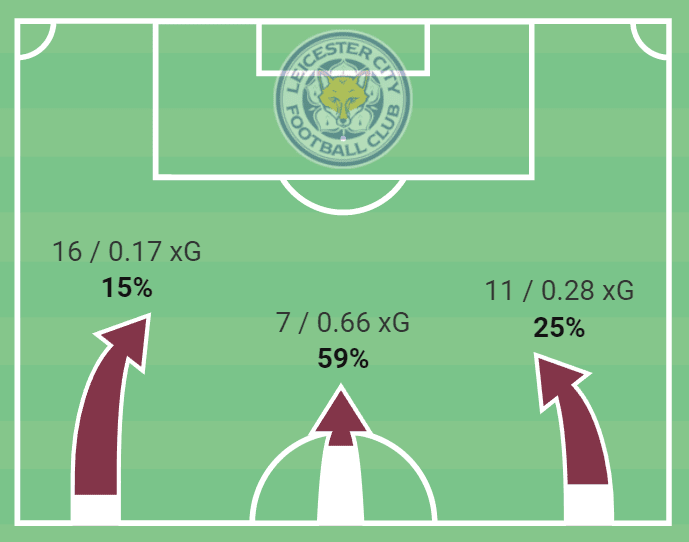
What let Leicester down in the final third was their crossing. The Foxes put 19 crosses into the box but had a horrific accuracy of just 26.5 percent.
Switch to a diamond
Leicester found themselves 3-2 down after Elmas scored his second of the game from some wonderful individual play but also because of woeful defending from the visitors.
Rodgers needed to change something from a tactical perspective because Leicester were repeating the same patterns of play over and over which were not working against Napoli’s sturdy 4-4-2 low block.
The answer was to bring on Patson Daka for Barnes and switch to a 4-4-2 diamond with Daka and Vardy up front. Bertrand pushed high to maintain the width in correlation to this.
The reason why Leicester’s crosses were so poor was that they were coming from deeper areas of the pitch and Napoli were dealing with them easily.
The manager wanted to get the fullbacks freer in more dangerous positions and so instructed Vardy and Daka to sit in the channels.
This pinned the Napoli fullbacks and forced them to remain narrow which allowed Castagne and Bertrand to receive the ball in better positions to cross.
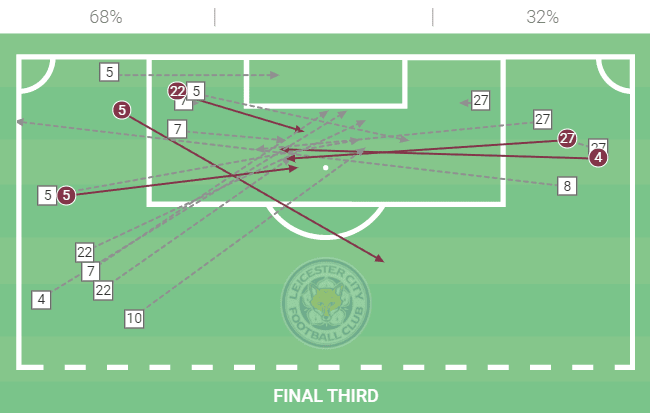
Here are all 19 crosses made by Leicester on Thursday evening. Especially on the left flank, the crosses that were in lower areas mainly came from earlier in the match, but the crosses were occurring closer to the goal when the tactical shift from Rodgers occurred.
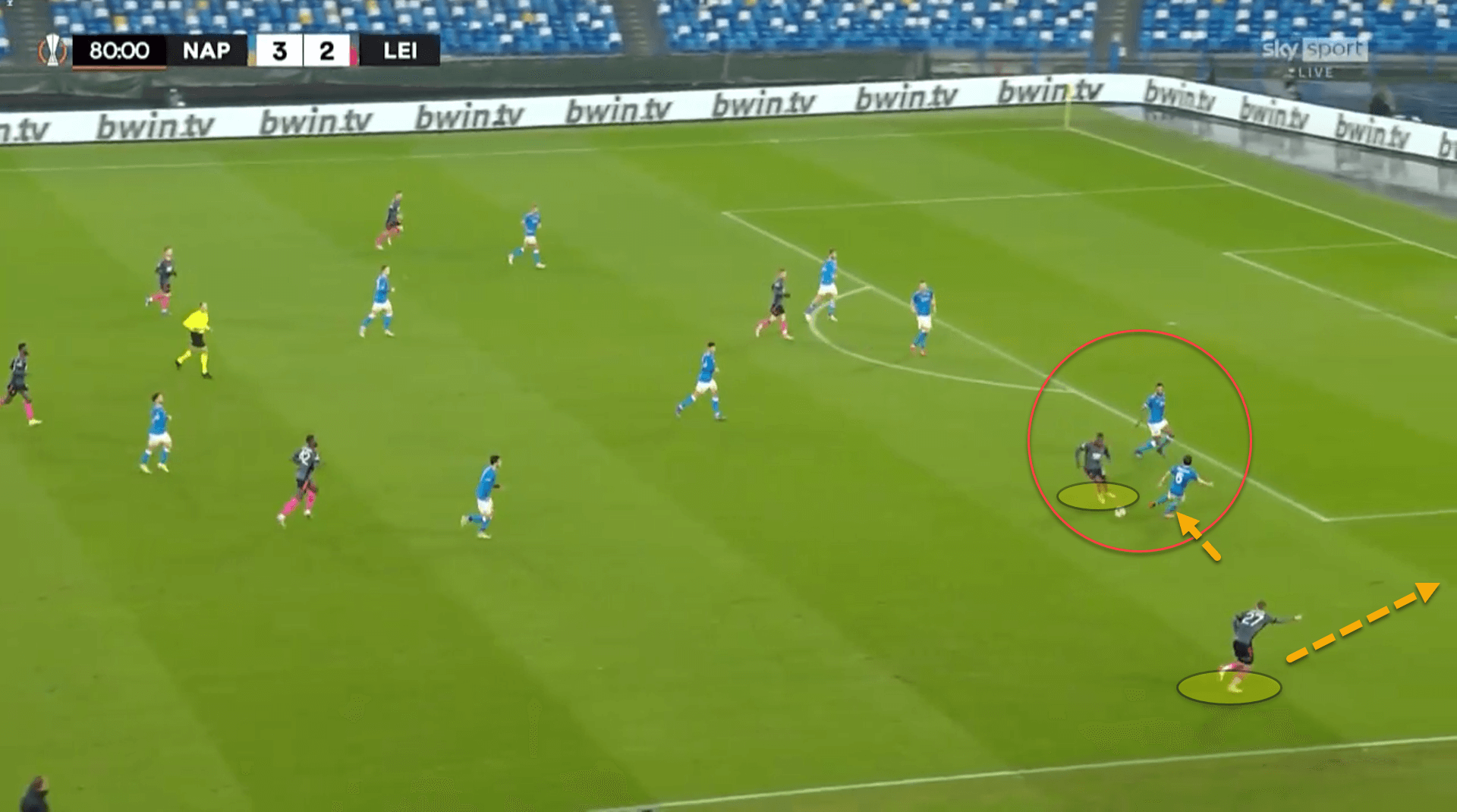
For instance, here, Daka has received in the space between the centre-back and left-back. This has dragged the two defenders closer together which has freed up Castagne in a good position to receive with time and space.
Again, and unfortunately for Rodgers, the quality of the crosses was simply not good enough and it really let Leicester down in the final third. Perhaps the Foxes could have had more luck on a different day but the service into the box was really disappointing from a Leicester perspective.
Conclusion
It is likely that there will be an overreaction in the English media to the side being knocked out of the Europa League and relegated to a UECL play-off. However, unlike Sunday’s game against Villa, Leicester were quite impressive against Napoli in a lot of areas.
There are still areas that need major improvement though. The team is extremely disorganised in the low block phase and struggles far too much from set-pieces, but some of their play in possession and their high pressing was excellent.
On another day maybe the game could have gone differently for the Foxes, but it wasn’t to be and now more questions will be asked of the former Liverpool and Celtic boss.





Comments